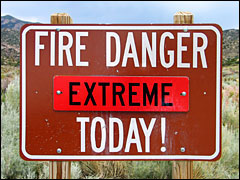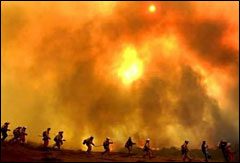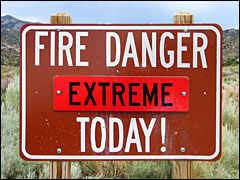Many wildland firefighters carry an instrument called a sling psychrometer. It consists of two encased thermometers, and is swung above the head on a short rope — making the firefighters appear not unlike David readying to slay Goliath. The instrument gives a quick field reading of relative humidity, one of the most important factors in predicting what a wildfire is going to do. Quick drops in relative humidity are a sure signal that the air is getting drier and that a fire is about to turn ugly.

Photo: iStockphoto
Wildland firefighters know weather. They study weather reports and projections. They track fronts moving across the continent. Just like you, they watch The Weather Channel. But firefighters also have to understand the sky. They have to be aware of wind, and to understand wind they have to recognize how different cloud formations indicate coming changes. The last thing a firefighter wants is to be caught on the business end of an unforeseen wind change.
So when wildland firefighters talk about climate change, it’s good to listen. They have been paying attention.
Toby Richards, a fire management officer for New Mexico’s Gila National Forest, realized that something was changing in climate patterns when he had to check on a fire a few years back that had ignited in mid-winter above 9,000 feet. “We went up to a lookout and watched this fire burning in an area that was normally under six feet of snow,” he remembers. “Every once in a while you will get a lightning strike up that high that burns a tree or two in the winter, but this fire grew to a hundred acres.”
Richards is not alone in observing changes in western wildfire patterns. Firefighters and fire scientists across the West have been noting for years that the fire season is getting longer, fires are growing larger, and many wildfires are starting to behave in ways that are considered unusual.
Unusual Weather We’re Having, Ain’t It?
About six years ago, climate scientist Anthony Westerling and a group of researchers from the Scripps Institution of Oceanography and the University of Arizona began to systematically examine the links between increasingly severe fire seasons and climate in the West. Most recently, Westerling and his fellow researchers pored over records from 1,166 large wildfires in the West from 1970 to 2003, tracking when fires ignited, how long they burned, and how much area they covered. They also gathered a wide variety of data from the region over the same time period on stream flow, temperature, precipitation, soil moisture, the timing of spring, and vegetation dryness.
“The trick was figuring out how to put all of the data together for analysis in just the right way,” Westerling says. “It looks straightforward after the fact, but it wasn’t so simple, and that is why it had not been done before.” When they had finished, the group was able to form a broad picture of the primary factors driving western wildfires. Their results were published in Science in August.
According to the team, the West has gotten hotter over the last couple of decades, with average spring and summer temperatures measuring nearly one degree Celsius (~1.8 °F) higher between 1987 and 2003 than during the previous 17 years. Those warmer temperatures melted the snowpack one to four weeks earlier in the spring, leaving western forests drier and primed for fire earlier in the year. Westerling says the earlier snowmelt provides a “tipping point” for wildfire activity. “In years when the snow melt is late in places like the mid-elevation forests of the northern Rockies, it never really dries out, and there are seldom any large wildfires,” he says. “Conversely, in the early melt years, the soils and vegetation dry out earlier, and are dry for longer. That is when most of the forest wildfires occur.”
The researchers found that a big jump in wildfire activity occurred in the mid-1980s — almost seven times more forested federal land burned between 1987 and 2003 than in the previous 17 years. Over the entire region, the length of the wildfire season increased by 78 days from 1970 to 2003. The season has grown more intense as well, with fires taking an average of only 7.5 days to control from 1970 to 1986, compared to an average of 37.1 days from 1987 to 2003.
While those trends are dramatic, they are not surprising to wildfire professionals. Tom Zimmerman, director of fire and aviation management for the Southwest division of the U.S. Forest Service, says, “Fire season now doesn’t end until it snows. We used to count on season-ending rains in August or September. Now we just hope for season-slowing rains.”
Richards agrees, and points to the May 2000 Cerro Grande Fire, a 900-acre controlled burn that escaped and turned into a nearly 48,000-acre monster near Los Alamos, N.M., as an example of a disastrous wildfire occurring outside of the normal season. “Cerro Grande was a springtime controlled burn, ignited at the right time and under the right conditions,” he says. “It should have just been a slow-moving ground fire, but it turned into a fast-moving fire that raced through the crowns of trees. It carried on like a fire that was lit in July.”
So we know the West is warming up, and those warmer temperatures are triggering earlier, longer, and more intense fire seasons. The question naturally arises: is global warming driving all of this?
Fuels and the Future
To answer that question, we turn to Tom Swetnam, the director of the University of Arizona Laboratory of Tree-Ring Research and a coauthor of the Science paper.
For the past two decades, Swetnam has been examining the fire scars nested within tree rings of long-lived species across the West, such as ponderosa pine, juniper, pinyon pine, and sequoia. By precisely dating each fire recorded within the rings, Swetnam has been able to reconstruct periods of increased regional fire activity going back to the 18th century. Using climate data from the same period, he has been able to show the connection between severe wildfire seasons that appear in the historical record and El Niño and La Niña climate patterns. The wet years of El Niño encourage growth in forests and vegetation, while the following dry La Niña periods turn the forests into a tinderbox. Could it be that the present ratcheting up in wildfire activity is just part of that long-term pattern, and not attributable to climate change?
“It is possible. El Niño and La Niña cycles are important,” says Swetnam. “However, the size and scale of the fires we have experienced over the last few years are orders of magnitude greater than anything from the past century. We are getting reports from the field of extreme fire behavior. In my scientific judgment, there is a link between human-caused global warming and wildfires, but we do not have the evidence to prove that yet. Within the scope of our study we can say that the West has gotten warmer and that has led to more wildfires regionally. Other research is being done on causation.”
Swetnam says that before he worked on this latest research, he was skeptical that climate was driving the latest increase in fire activity. He thought the main drivers were forest conditions — the large amount of fuels that had built up in western forests after decades of fire suppression and exclusion. In other words, Smokey Bear did his job a little too well. We have just been putting out too many fires.

Into the line of fire.
Photo: resourcescommittee.house.gov
Richards and Zimmerman confirm that decades’ worth of downed fuels make for trouble. But like most people in the field, they realize that both climate and management play a role, each varying in importance depending on where you are.
“The fuels management story is very important in certain sub-regions, but the areas most affected by management are not generating the biggest share of the increase in wildfire,” Westerling says. “The biggest share of the increase occurred in mid-elevation forests in the northern Rockies where fire activity was least affected by past management. Even in a place like the Southwest, where past management is very important, it is still the case that the area burned in early snowmelt years is more than two and half times as much as the area burned in late snowmelt years.”
While the study points to a dark future for forests in the West, the researchers are not so fatalistic. There is still time to do something about it.
“The public and policy-makers need to wake up to the great risks facing our ecosystems and human communities,” says Swetnam. “We are all going to have to learn to live with fire and reintroduce it into our ecosystems as prescribed fire or natural fire outside of wilderness.”
Some media reports regarding the study have played up the climate versus management argument, but the researchers say that the reception from land managers and firefighters has been mostly positive. In fact, many firefighters and land managers are glad that someone has been able to systematically document an idea and argument that has been floating around the firefighting camp for years.
“On the one hand, there is a feeling of vindication, to see someone document what they have had a gut feeling about already,” says Westerling. “On the other hand, there is some apprehension about what comes next. They know they are the ones who are going to be expected to take care of any problems in our public forests, and this is one they can’t solve on their own.”


